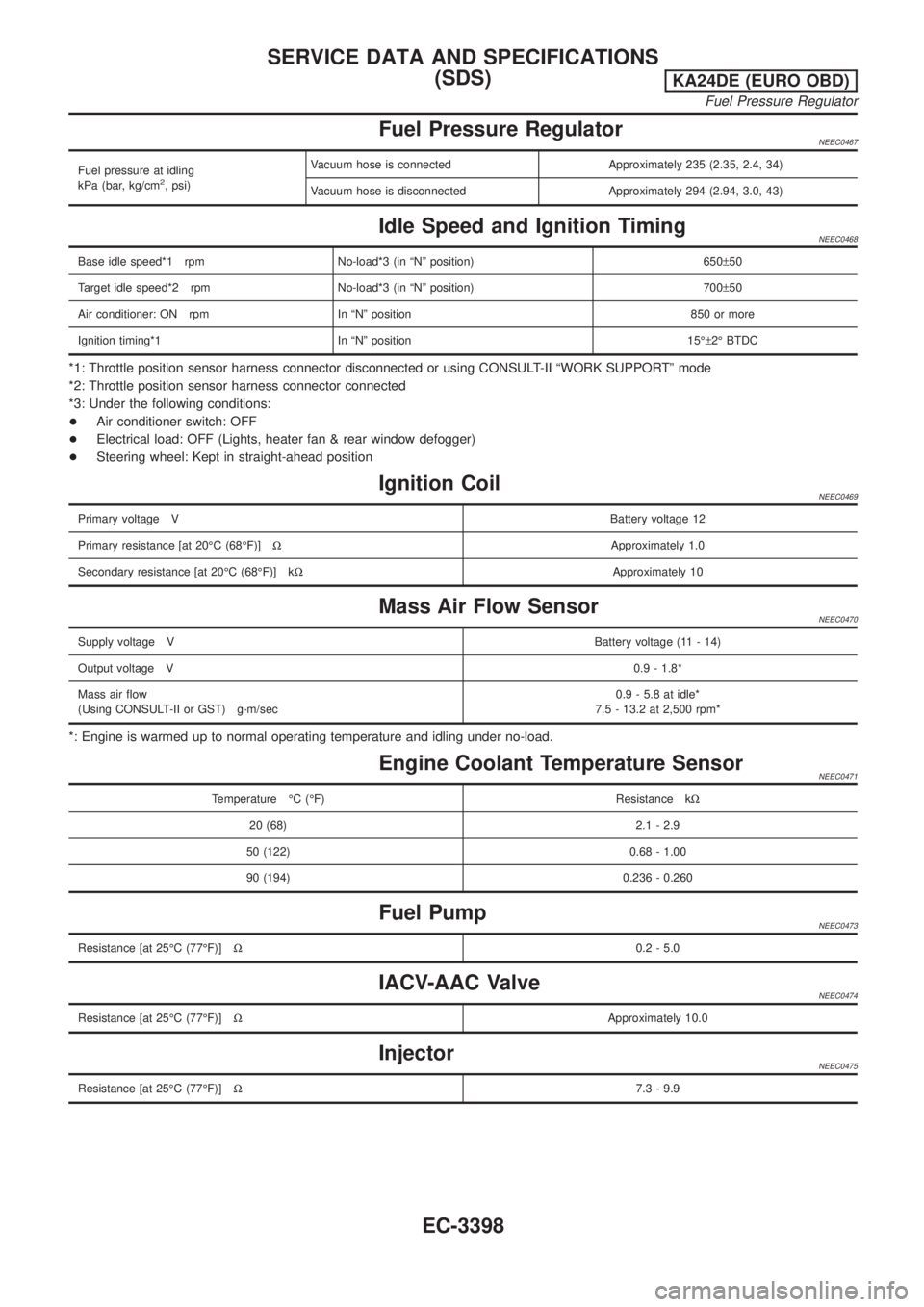Page 416 of 1306
MODEL WITH AUTO AIR CONDITIONERNEEC0461S02
GEC259A
IACV-FICD SOLENOID VALVEKA24DE (EURO OBD)
Wiring Diagram
EC-3391
Page 417 of 1306
Diagnostic Procedure=NEEC0464
1 CHECK OVERALL FUNCTION
1. Start engine and warm it up to normal operating temperature.
2. Check idle speed.
700±50 rpm
If NG, adjust idle speed.
3. Push air conditioner switch ON and turn fan switch to 4-speed.
4. Recheck idle speed.
MEF634E
850 rpm or more
OK or NG
OK©INSPECTION END
NG©GO TO 2.
2 CHECK AIR CONDITIONER FUNCTION
Check if air conditioner compressor functions normally.
OK or NG
OK©GO TO 3.
NG©Refer to ªSymptom Tableº in ªTROUBLE DIAGNOSISº, HA section.
IACV-FICD SOLENOID VALVEKA24DE (EURO OBD)
Diagnostic Procedure
EC-3392
Page 418 of 1306
3 CHECK POWER SUPPLY
1. Stop engine.
2. Disconnect IACV-FICD solenoid valve harness connector.
SEF342V
3. Start engine, then push A/C switch ON and turn fan switch to 4-speed.
4. Check voltage between terminal 1 and ground with CONSULT-II or tester.
SEC281D
Voltage: Battery voltage
OK or NG
OK©GO TO 5.
NG©GO TO 4.
4 DETECT MALFUNCTIONING PART
Check the following.
+Harness connectors E101, M5
+Harness for open or short between IACV-FICD solenoid valve and air conditioner relay
©Repair open circuit, short to ground or short to power in harness or connectors.
IACV-FICD SOLENOID VALVEKA24DE (EURO OBD)
Diagnostic Procedure
EC-3393
Page 419 of 1306

5 CHECK GROUND CIRCUIT
1. Turn ignition switch OFF.
2. Check harness continuity as follows.
MTBL1310
Continuity should exist.
3. Also check harness for short to ground or short to power.
OK or NG
OK©GO TO 7.
NG©GO TO 6.
6 DETECT MALFUNCTIONING PART
MANUAL AIR CONDITIONER
Check the following.
+Harness connectors E101, M5
+IACV-FICD solenoid valve
+Ambient temperature switch
+Diode M83
+Harness connectors M5, E101
+Check the harness for open or short between air conditioner relay and ambient temperature switch
+Check the harness for open or short between diode M83 and ECM
+Check the harness for open or short between ambient temperature switch and ECM
+Check the harness for open or short between ambient temperature switch and ground
AUTO AIR CONDITIONER
Check the following.
+Harness connectors E101, M5
+IACV-FICD solenoid valve
+Diode M83
+Check the harness for open or short between air conditioner relay and ECM
+Check the harness for open or short between diode and A/C auto amp
+Check the harness for open or short between A/C auto amp and ECM
©Repair open circuit or short to power in harness or connectors.
IACV-FICD SOLENOID VALVEKA24DE (EURO OBD)
Diagnostic Procedure
EC-3394
Page 423 of 1306

Fuel Pressure RegulatorNEEC0467
Fuel pressure at idling
kPa (bar, kg/cm2, psi)Vacuum hose is connected Approximately 235 (2.35, 2.4, 34)
Vacuum hose is disconnected Approximately 294 (2.94, 3.0, 43)
Idle Speed and Ignition TimingNEEC0468
Base idle speed*1 rpm No-load*3 (in ªNº position) 650±50
Target idle speed*2 rpm No-load*3 (in ªNº position) 700±50
Air conditioner: ON rpm In ªNº position 850 or more
Ignition timing*1 In ªNº position 15ɱ2É BTDC
*1: Throttle position sensor harness connector disconnected or using CONSULT-II ªWORK SUPPORTº mode
*2: Throttle position sensor harness connector connected
*3: Under the following conditions:
+Air conditioner switch: OFF
+Electrical load: OFF (Lights, heater fan & rear window defogger)
+Steering wheel: Kept in straight-ahead position
Ignition CoilNEEC0469
Primary voltage VBattery voltage 12
Primary resistance [at 20ÉC (68ÉF)]WApproximately 1.0
Secondary resistance [at 20ÉC (68ÉF)] kWApproximately 10
Mass Air Flow SensorNEEC0470
Supply voltage VBattery voltage (11 - 14)
Output voltage V0.9 - 1.8*
Mass air flow
(Using CONSULT-II or GST) g´m/sec0.9 - 5.8 at idle*
7.5 - 13.2 at 2,500 rpm*
*: Engine is warmed up to normal operating temperature and idling under no-load.
Engine Coolant Temperature SensorNEEC0471
Temperature ÉC (ÉF) Resistance kW
20 (68) 2.1 - 2.9
50 (122) 0.68 - 1.00
90 (194) 0.236 - 0.260
Fuel PumpNEEC0473
Resistance [at 25ÉC (77ÉF)]W0.2 - 5.0
IACV-AAC ValveNEEC0474
Resistance [at 25ÉC (77ÉF)]WApproximately 10.0
InjectorNEEC0475
Resistance [at 25ÉC (77ÉF)]W7.3 - 9.9
SERVICE DATA AND SPECIFICATIONS
(SDS)
KA24DE (EURO OBD)
Fuel Pressure Regulator
EC-3398
Page 424 of 1306
Throttle Position Sensor=NEEC0477
Throttle valve conditions Voltage (at normal operating temp., engine off, ignition switch on)
Completely closed (a)0.2 - 0.8V
Partially openBetween (a) and (b)
Completely open (b)3.5 - 4.5V
Heated Oxygen Sensor 1 HeaterNEEC0478
Resistance [at 25ÉC (77ÉF)]W2.3 - 4.3
Calculated Load ValueNEEC0479
Calculated load value %
(Using CONSULT-II or GST)
At idle9.5 - 34.0%
At 2,500 rpm13.9 - 24.9%
Intake Air Temperature SensorNEEC0480
Temperature ÉC (ÉF) Resistance kW
20 (68) 2.1 - 2.9
80 (176) 0.27 - 0.38
Heated Oxygen Sensor 2 HeaterNEEC0483
Resistance [at 25ÉC (77ÉF)]W2.3 - 4.3
Crankshaft Position Sensor (OBD)NEEC0484
Resistance [at 20ÉC (68ÉF)]W512 - 632
SERVICE DATA AND SPECIFICATIONS
(SDS)
KA24DE (EURO OBD)
Throttle Position Sensor
EC-3399
Page 435 of 1306
System Chart
Input (Sensor) ECM Function Output (Actuator)
+Electronic control fuel injection pump
+Crankshaft position sensor (TDC)
+Engine coolant temperature sensor
+Accelerator position sensor
+Accelerator position switch
+Park/Neutral position (PNP) switch
+Ignition switch
+Battery voltage
+Vehicle speed sensor
+Air conditioner switch
+Stop lamp switch
+Charge air pressure sensor
+Intake air temperature sensorFuel injection control Electronic control fuel injection pump
Fuel injection timing control Electronic control fuel injection pump
Fuel cut control Electronic control fuel injection pump
Glow control system Glow relay & glow lamp
On board diagnostic system MIL (On the instrument panel)
EGR volume control EGR volume control valve
Cooling fan control Cooling fan relay
Air conditioning cut control Air conditioner relay
ENGINE AND EMISSION CONTROL OVERALL SYSTEMYD25DDTi
EC-3410
Page 436 of 1306

Fuel Injection Control System
DESCRIPTION
System description
Three types of fuel injection control are provided to accommodate engine operating conditions; normal
control, idle control and start control. The ECM determines the appropriate fuel injection control. Under each
control, the amount of fuel injected is compensated to improve engine performance.
Pulse signals are exchanged between ECM and electronic control fuel injection pump (control unit is built-
in). The fuel injection pump control unit performs duty control on the spill valve (built into the fuel injection
pump) according to the input signals to compensate the amount of fuel injected to the preset value.
Start control
Input/output signal chart
Sensor Input Signal to ECM ECM Function Actuator
Engine coolant temperature sensor Engine coolant temperature
Fuel injection con-
trol (start control)Electronic control fuel injec-
tion pump Crankshaft position sensor (TDC) Engine speed
Ignition switch Start signal
When the ECM receives a start signal from the ignition switch,
the ECM adapts the fuel injection system for the start control.
The amount of fuel injected at engine starting is a preset program
value in the ECM. The program is determined by the engine
speed and engine coolant temperature.
For better startability under cool engine conditions, the lower the
coolant temperature becomes, the greater the amount of fuel
injected. The ECM ends the start control when the engine speed
reaches the specific value, and shifts the control to the normal
or idle control.
Idle control
Input/output signal chart
Sensor Input Signal to ECM ECM Function Actuator
Engine coolant temperature sensor Engine coolant temperature
Fuel injection con-
trol (Idle control)Electronic control fuel injec-
tion pump Crankshaft position sensor (TDC) Engine speed
Park/Neutral position (PNP) switch Gear position
Battery Battery voltage
Accelerator position switch Idle position
Vehicle speed sensor Vehicle speed
Air conditioner switch Air conditioner signal
Intake air temperature sensor Intake air temperature
When the ECM determines that the engine speed is at idle, the fuel injection system is adapted for the idle
control. The ECM regulates the amount of fuel injected corresponding to changes in load applied to the
engine to keep engine speed constant. The ECM also provides the system with a fast idle control in response
to the engine coolant temperature and heat up switch signal.
SEF648S
ENGINE AND EMISSION BASIC CONTROL SYSTEM
DESCRIPTIONYD25DDTi
EC-3411